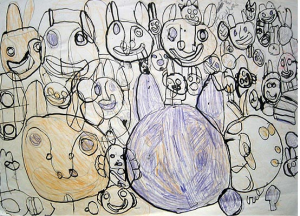Harold Jeffries’ imagery and working methods are an outgrowth of his personal obsessions and inner world. Nearly every piece has as its basis a gridwork of lines, forming squares, rectangles, circles and other forms which resemble an isolated section of a vast blueprint outlining some lost Minoan palace. If asked, Jeffries will tell you that these are indeed blueprints. They are part of his lifelong obsession to create blueprinted plans for Heaven. This project has no beginning, middle or end. The portion of the plans that Jeffries draws at any one time simply reflects his thoughts at that moment, and do not advance the project along any conceivable time line, a fitting solution for planning what is infinite and eternal.
The technique of layering, be it of forms, media, or concepts, is another hallmark of Jeffries’ art. Resulting in images which appear to be wholly abstract, Jeffries will sometimes layer additional media over his original blueprint drawings. He will alternate drawing media with washes of paint, obscuring the original blueprint in one spot, reemphasizing it in another, drawing new plans on top of it in yet another place. Sometimes all or part of the original drawing is overlaid with a tight mesh of faces and human forms. These are variously described by Jeffries as ghosts, or spirits, or voices. To him they are real, and they give the viewer an arresting glimpse of Jeffries waking life.
On occasion, Jeffries has taken his blueprints and worked them into 3-dimensional form. Harold is extremely interested in the use of construction materials. This fascination is evident in the decisions he makes to bring his ideas to reality of form. He prefers to reuse discarded materials like empty bottles. The act of building becomes a metaphor for Harold’s life and his sense of the world. He finds comfort in the idea that something both beautiful and useful is being created while the burden that would otherwise have been placed upon existing landfills is reduced.


